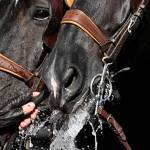Water: The Overlooked Nutrient

The most important nutrient in the horse’s diet is one that is rarely added to feeds: water. Though it is often overlooked in discussions involving equine nutrition, water could be considered the first limiting nutrient of all horses, as they cannot survive for as many days without water as they can without feed. The amount of water required by the horse is determined by the magnitude of water losses from its body. These losses occur through feces, urine, respiratory gases, and sweat and, in the case of lactating mares, milk.
These losses are affected by the amount, type, and quality of the feed consumed, environmental conditions and the health, physiological state, and physical activity of the horse. Horses will generally consume as much water as they need if given access to a palatable water source. Horses at rest in a moderate climate will generally consume between three and seven liters of water per 220 lb (100 kg) of bodyweight. This translates to around 4-9 gallons for a 1,100-lb (500-kg) horse.
Diet plays a major role in determining voluntary water intake and requirements. As a general rule, water intake is proportional to dry matter intake, but the composition and digestibility of the diet can alter this relationship substantially.
Horses consuming all-hay diets drink more than horses fed a large amount of concentrate coupled with hay or a complete pelleted diet. In a study conducted by Kentucky Equine Research, horses fed all-forage diets ate 19% more dry matter to provide a similar caloric intake to those fed a mixed diet, and they drank 26% more water.
In another study, horses fed about 13 lb (5.8 kg) of a hay-only diet drank 40 lb (17.8 kg) water compared to 22 lb (10.1 kg) water consumed by horses fed 4 lb (1.8 kg) grain plus 3 lb (1.3 kg) hay, which was partly because of lower dry matter intake, as well as different dietary composition.
Fiber intake affects water requirements for two reasons. First, when horses consume forage, water shifts from the interstitial space into the gut. This results in a decrease in plasma volume that triggers a thirst response. A meal of 5 lb (2.27 kg) of hay resulted in elevated total plasma protein (an indirect measure of decreased plasma volume) and greater water intake than when a similar-sized grain meal was fed. Second, plant fiber has a greater water-holding capacity and is less digestible than other components of the diet, resulting in greater fecal water losses. The physical form of forages also affects fecal water losses.
In a digestibility study, horses fed alfalfa hay in a long-stem form had significantly wetter feces (81.5% versus 75.2%) than when an identical amount of the same forage was fed in a pelleted form.
Diet can also affect urinary water loss. High salt intake increases urine output and stimulates thirst. Also, protein intake above the horse’s requirement increases water intake and urinary output as the horse voids excess nitrogen via urine. Besides increasing water requirements, this creates an environmental hazard for stalled horses since the nitrogen in urine is broken down into ammonia in the horse’s bedding. Body condition can affect water intake as well. Because fat is low in water content compared to lean body tissue, obese animals typically require less water than animals maintained at a more optimal body condition.
Ambient temperature influences water intake. Horses typically drink less water in cold weather. Water consumption of weanlings exposed to cold temperatures, -8°C and -17°C, was compared to that of weanlings housed in temperatures of 8°C and above. Water intake was up to 14% lower in weanlings maintained in cold temperatures.
Heat and humidity increase water requirements, especially in exercising horses. In one trial, daily water intake increased 79% when horses transitioned from a thermoneutral environment (20°C and 45-50% relative humidity) to a hot, humid one (33-35°C and 80- 85% relative humidity).
In addition to temperature and humidity, other factors impact water intake of equine athletes, primarily duration and intensity of work as well as acclimation of the horse to the environment. Depending on the conditions in which a horse is exercised, total water intake by a 1,100-lb (500-kg) horse could reach over 90 liters per day.
Aside from equine athletes, lactating mares drink more water than other horses. Increased intake is likely due to a combination of factors, principally the fluid losses associated with milk secretion and the increased consumption of feed to support milk production. Though other factors, such as diet composition and ambient temperature, will play a role in volume of water consumed, 1,100-lb (500-kg) lactating mares may drink up to 75 liters per day.
Certain illnesses predispose a horse to increased water consumption. A horse with diarrhea but with normal appetite and thirst might have incredible fecal water losses. The horse compensates for fluid losses by boosting water intake and decreasing urine output. Without resolution of the diarrhea, however, dehydration is likely.
Polydipsia, or excessive drinking, especially when combined with other signs such as hirsutism, might be indicative of equine Cushing’s disease or renal insufficiency.
Though often neglected in nutrition discussions, water is vital for the health and well-being of all horses. As such, horses should have access to fresh water at all times.








